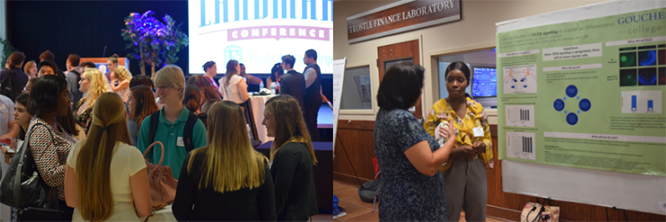Event Title
Location
Presentations Session 2 - Hoover 214
Department
Biology
Start Date
11-7-2019 2:45 PM
End Date
11-7-2019 3:45 PM
Description
The BIN1 gene product, Amphiphysin 2, has been shown to act as a tumor suppressor (Prokic, et al., 2014) working to stop uncontrolled cell growth. It accomplishes this by several mechanisms most notably the MYC-dependent pathway (Prokic, et al., 2014). BIN1 contains several protein domains: BIN-amphiphysin/Rvs (N-BAR), phosphoinositide (PI), clathrin and AP2 (CLAP), Mycbinding domain (MBD), and Src homology 3(SH3). In non-malignant cells normal levels of BIN1 can activate Programed Cell Death, and it can inhibit excessive growth by binding to N-Myc and blocking its ability to activate the cell cycle genes. (Prokic, 2014). However in many cancers, BIN1 is deleted, or alternatively spliced to to knock out these protective functions. Alternative splicing to include exon 12A in BIN1 has been found in several tumors and inclusion of this exon is thought to disable the BIN1 protein from binding to Myc. Our lab has been investigating the cellular mechanisms of transformation by the simian virus 40 (SV40) large T-antigen and we hypothesized that this oncoprotein would cause the production of the Bin1+12A isoform in human diploid fibroblast (HDF). Our preliminary results have detected a new RNA transcript in HDF cells expressing T antigen (HDF+T) that has been spliced to remove exons 12-18. We are currently confirming if this transcript creates a stable protein by Western blot analysis and if sufficient levels of BIN1 are detected then immunofluorescence will determine the cellular location. This data will help elucidate the role of BIN1 in tumor progression.
Recommended Citation
Monostra, Carli, "The correlation of a novel BIN1 isoform and the expression of SV40 T antigen in human diploid fibroblasts" (2019). Landmark Conference Summer Research Symposium. 7.
https://jayscholar.etown.edu/landmark/2019/july11/7
Included in
The correlation of a novel BIN1 isoform and the expression of SV40 T antigen in human diploid fibroblasts
Presentations Session 2 - Hoover 214
The BIN1 gene product, Amphiphysin 2, has been shown to act as a tumor suppressor (Prokic, et al., 2014) working to stop uncontrolled cell growth. It accomplishes this by several mechanisms most notably the MYC-dependent pathway (Prokic, et al., 2014). BIN1 contains several protein domains: BIN-amphiphysin/Rvs (N-BAR), phosphoinositide (PI), clathrin and AP2 (CLAP), Mycbinding domain (MBD), and Src homology 3(SH3). In non-malignant cells normal levels of BIN1 can activate Programed Cell Death, and it can inhibit excessive growth by binding to N-Myc and blocking its ability to activate the cell cycle genes. (Prokic, 2014). However in many cancers, BIN1 is deleted, or alternatively spliced to to knock out these protective functions. Alternative splicing to include exon 12A in BIN1 has been found in several tumors and inclusion of this exon is thought to disable the BIN1 protein from binding to Myc. Our lab has been investigating the cellular mechanisms of transformation by the simian virus 40 (SV40) large T-antigen and we hypothesized that this oncoprotein would cause the production of the Bin1+12A isoform in human diploid fibroblast (HDF). Our preliminary results have detected a new RNA transcript in HDF cells expressing T antigen (HDF+T) that has been spliced to remove exons 12-18. We are currently confirming if this transcript creates a stable protein by Western blot analysis and if sufficient levels of BIN1 are detected then immunofluorescence will determine the cellular location. This data will help elucidate the role of BIN1 in tumor progression.




Comments
Faculty mentor: Jane Cavender, Elizabethtown College.